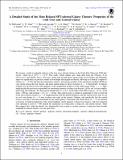A Detailed Study of the Most Relaxed SPT-selected Galaxy Clusters: Properties of the Cool Core and Central Galaxy
Author(s)
McDonald, Michael A.; Allen, SW; Hlavacek-Larrondo, J; Mantz, AB; Bayliss, Matthew B; Benson, BA; Brodwin, M; Bulbul, E; Canning, REA; Chiu, I; Forman, WR; Garmire, GP; Gupta, N; Khullar, G; Mohr, JJ; Reichardt, CL; Schrabback, T; ... Show more Show less
DownloadPublished version (1.419Mb)
Publisher Policy
Publisher Policy
Article is made available in accordance with the publisher's policy and may be subject to US copyright law. Please refer to the publisher's site for terms of use.
Terms of use
Metadata
Show full item recordAbstract
© 2019. The American Astronomical Society. All rights reserved. We present a multi-wavelength analysis of the four most relaxed clusters in the South Pole Telescope 2500 deg2 survey, which lie at 0.55 < z < 0.75. This study, which utilizes new, deep data from the Chandra X-ray Observatory and Hubble Space Telescope, along with ground-based spectroscopy from Gemini and Magellan, improves significantly on previous studies in both depth and angular resolution, allowing us to directly compare to clusters at z ∼ 0. We find that the temperature, density, and entropy profiles of the intracluster medium (ICM) are very similar among the four clusters, and share similar shapes to those of clusters at z ∼ 0. Specifically, we find no evidence for deviations from self-similarity in the temperature profile over the radial range 10 kpc < r < 1 Mpc, implying that the processes responsible for preventing runaway cooling over the past ≳6 Gyr are, at least roughly, preserving self-similarity. We find typical metallicities of ∼0.3 Z o in the bulk of the ICM, rising to ∼0.5 Z o in the inner ∼100 kpc, and reaching ∼1 Z o at r < 10 kpc. This central excess is similar in magnitude to what is observed in the most relaxed clusters at z ∼ 0, suggesting that both the global metallicity and the central excess that we see in cool core clusters at z ∼ 0 were in place very early in the cluster's lifetime, and specifically that the central excess is not due to late-time enrichment by the central galaxy. Consistent with observations at z ∼ 0, we measure a diversity of stellar populations in the central brightest cluster galaxies of these four clusters, with star formation rates spanning a factor of ∼500, despite the similarities in cooling time, cooling rate, and central entropy. These data suggest that, while the details vary dramatically from system to system, runaway cooling has been broadly regulated in relaxed clusters over the past 6 Gyr.
Date issued
2019Department
MIT Kavli Institute for Astrophysics and Space Research; Massachusetts Institute of Technology. Department of PhysicsJournal
Astrophysical Journal
Publisher
American Astronomical Society